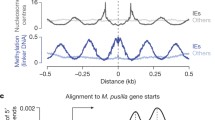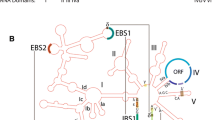Abstract
The following unusual tRNAs have recently been discovered in the genomes of Archaea and primitive Eukaryota: multiple-intron-containing tRNAs, which have more than one intron; split tRNAs, which are produced from two pieces of RNA transcribed from separate genes; tri-split tRNAs, which are produced from three separate genes; and permuted tRNA, in which the 5′ and 3′ halves are encoded with permuted orientations within a single gene. All these disrupted tRNA genes can form mature contiguous tRNA, which is aminoacylated after processing by cis or trans splicing. The discovery of such tRNA disruptions has raised the question of when and why these complex tRNA processing pathways emerged during the evolution of life. Many previous reports have noted that tRNA genes contain a single intron in the anticodon loop region, a feature common throughout all three domains of life, suggesting an ancient trait of the last universal common ancestor. In this context, these unique tRNA disruptions recently found only in Archaea and primitive Eukaryota provide new insight into the origin and evolution of tRNA genes, encouraging further research in this field. In this paper, we summarize the phylogeny, structure, and processing machinery of all known types of disrupted tRNAs and discuss possible evolutionary scenarios for these tRNA genes.



Similar content being viewed by others
References
Abelson J, Trotta CR, Li H (1998) tRNA splicing. J Biol Chem 273:12685–12688
Adams PL, Stahley MR, Gill ML, Kosek AB, Wang J, Strobel SA (2004) Crystal structure of a group I intron splicing intermediate. RNA 10(12):1867–1887
Calvin K, Li H (2008) RNA-splicing endonuclease structure and function. Cell Mol Life Sci 65:1176–1185
Chan PP, Lowe TM (2009) GtRNAdb: a database of transfer RNA genes detected in genomic sequence. Nucleic Acids Res 37:D93–D97
Cox C, Foster P, Hirt R, Harris S, Embley TM (2008) The archaebacterial origin of eukaryotes. Proc Natl Acad Sci USA 105:20049–20050
Crick FH (1958) On protein synthesis. Symp Soc Exp Biol 12:138–163
d’Orval B, Bortolin ML, Gaspin C, Bachellerie JP (2001) Box C/D RNA guides for the ribose methylation of archaeal tRNAs. The tRNATrp intron guides the formation of two ribose-methylated nucleosides in the mature tRNATrp. Nucleic Acids Res 29:4518–4529
Di Giulio M (1992) On the origin of the transfer RNA molecule. J Theor Biol 159:199–214
Di Giulio M (1999) The non-monophyletic origin of tRNA molecule. J Theor Biol 197:403–414
Di Giulio M (2006) The non-monophyletic origin of the tRNA molecule and the origin of genes only after the evolutionary stage of the last universal common ancestor (LUCA). J Theor Biol 240:343–352
Di Giulio M (2008) Permuted tRNA genes of Cyanidioschyzon merolae, the origin of the tRNA molecule and the root of the Eukarya domain. J Theor Biol 253:587–592
Diener JL, Moore PB (1998) Solution structure of a substrate for the archaeal pre-tRNA splicing endonucleases: the bulge-helix-bulge motif. Mol Cell 1:883–894
Evrard JC, Kuntz M, Straus NA, Weil JH (1988) A class-I intron in a cyanelle tRNA gene from Cyanophora paradoxa: phylogenetic relationship between cyanelles and plant chloroplasts. Gene 71:115–122
Fujishima K, Sugahara J, Tomita M, Kanai A (2008) Sequence evidence in the archaeal genomes that tRNAs emerged through the combination of ancestral genes as 5′ and 3′ tRNA halves. PLoS ONE 3(2):e1622
Fujishima K, Sugahara J, Kikuta K, Hirano R, Sato A, Tomita M, Kanai A (2009) Tri-split tRNA is a transfer RNA made from 3 transcripts that provides insight into the evolution of fragmented tRNAs in archaea. Proc Natl Acad Sci USA 106:2683–2687
Ghavidel A, Kislinger T, Pogoutse O, Sopko R, Jurisica I, Emili A (2007) Impaired tRNA nuclear export links DNA damage and cell-cycle checkpoint. Cell 131:915–926
Goodman HM, Olson MV, Hall BD (1977) Nucleotide sequence of a mutant eukaryotic gene: the yeast tyrosine-inserting ochre suppressor SUP4-o. Proc Natl Acad Sci USA 74:5453–5457
Haiser H, Karginov F, Hannon G, Elliot M (2008) Developmentally regulated cleavage of tRNAs in the bacterium Streptomyces coelicolor. Nucleic Acids Res 36:732–741
Haugen P, Simon DM, Bhattacharya D (2005) The natural history of group I introns. Trends Genet 21:111–119
Hipps D, Shiba K, Henderson B, Schimmel P (1995) Operational RNA code for amino acids: species-specific aminoacylation of minihelices switched by a single nucleotide. Proc Natl Acad Sci USA 92:5550–5552
Hoagland MB, Stephenson ML, Scott JF, Hecht LI, Zamecnik PC (1958) A soluble ribonucleic acid intermediate in protein synthesis. J Biol Chem 231:241–257
Holley RW, Everett GA, Madison JT, Zamir A (1965) Nucleotide sequences in the yeast alanine transfer ribonucleic acid. J Biol Chem 240:2122–2128
Jöchl C, Rederstorff M, Hertel J, Stadler P, Hofacker I, Schrettl M, Haas H, Huttenhofer A (2008) Small ncRNA transcriptome analysis from Aspergillus fumigatus suggests a novel mechanism for regulation of protein synthesis. Nucleic Acids Res 36:2677–2689
Kaine BP, Gupta R, Woese CR (1983) Putative introns in tRNA genes of prokaryotes. Proc Natl Acad Sci USA 80:3309–3312
Kuhsel MG, Strickland R, Palmer JD (1990) An ancient group I intron shared by eubacteria and chloroplasts. Science 250:1570–1573
Lake JA, Henderson E, Oakes M, Clark MW (1984) Eocytes: a new ribosome structure indicates a kingdom with a close relationship to eukaryotes. Proc Natl Acad Sci USA 81:3786–3790
Li H, Trotta CR, Abelson J (1998) Crystal structure and evolution of a transfer RNA splicing enzyme. Science 280:279–284
Lowe TM, Eddy ST (1997) tRNAscan-SE: a program for improved detection of transfer RNA genes in genomic sequence. Nucleic Acids Res 25:955–964
Marck C, Grosjean H (2002) tRNomics: analysis of tRNA genes from 50 genomes of Eukarya, Archaea, and Bacteria reveals anticodon-sparing strategies and domain-specific features. RNA 8:1189–1232
Marck C, Grosjean H (2003) Identification of BHB splicing motifs in intron-containing tRNAs from 18 archaea: evolutionary implications. RNA 9:1516–1531
Randau L, Söll D (2008) Transfer RNA genes in pieces. EMBO Rep 9:623–628
Randau L, Calvin K, Hall M, Yuan J, Podar M, Li H, Söll D (2005a) The heteromeric Nanoarchaeum equitans splicing endonuclease cleaves noncanonical bulge-helix-bulge motifs of joined tRNA halves. Proc Natl Acad Sci USA 102:17934–17939
Randau L, Munch R, Hohn MJ, Jahn D, Söll D (2005b) Nanoarchaeum equitans creates functional tRNAs from separate genes for their 5′- and 3′-halves. Nature 433:537–541
Randau L, Pearson M, Söll D (2005c) The complete set of tRNA species in Nanoarchaeum equitans. FEBS Lett 579:2945–2947
Rauhut R, Green PR, Abelson J (1990) Yeast tRNA-splicing endonuclease is a heterotrimeric enzyme. J Biol Chem 265:18180–18184
Reinhold-Hurek B, Shub DA (1992) Self-splicing introns in tRNA genes of widely divergent bacteria. Nature 357:173–176
Soma A, Onodera A, Sugahara J, Kanai A, Yachie N, Tomita M, Kawamura F, Sekine Y (2007) Permuted tRNA genes expressed via a circular RNA intermediate in Cyanidioschyzon merolae. Science 318:450–453
Sprinzl M, Horn C, Brown M, Ioudovitch A, Steinberg S (1998) Compilation of tRNA sequences and sequences of tRNA genes. Nucleic Acids Res 26:148–153
Strobel MC, Abelson J (1986) Effect of intron mutations on processing and function of Saccharomyces cerevisiae SUP53 tRNA in vitro and in vivo. Mol Cell Biol 6(7):2663–2673
Sugahara J, Yachie N, Sekine Y, Soma A, Matsui M, Tomita M, Kanai A (2006) SPLITS: a new program for predicting split and intron-containing tRNA genes at the genome level. In Silico Biol 6:411–418
Sugahara J, Yachie N, Arakawa K, Tomita M (2007) In silico screening of archaeal tRNA-encoding genes having multiple introns with bulge-helix-bulge splicing motifs. RNA 13:671–681
Sugahara J, Kikuta K, Fujishima K, Yachie N, Tomita M, Kanai A (2008) Comprehensive analysis of archaeal tRNA genes reveals rapid increase of tRNA introns in the order thermoproteales. Mol Biol Evol 25:2709–2716
Szweykowska-Kulinska Z, Senger B, Keith G, Fasiolo F, Grosjean H (1994) Intron-dependent formation of pseudouridines in the anticodon of Saccharomyces cerevisiae minor tRNAIle. EMBO J 13:4636–4644
Tanaka T, Kikuchi Y (2001) Origin of the cloverleaf shape of transfer RNA—the double-hairpin model: implication of the role of tRNA intron and the long extra loop. Viva Origino 29:134–142
Tocchini-Valentini GD, Fruscoloni P, Tocchini-Valentini GP (2005a) Coevolution of tRNA intron motifs and tRNA endonuclease architecture in Archaea. Proc Natl Acad Sci USA 102:15418–15422
Tocchini-Valentini GD, Fruscoloni P, Tocchini-Valentini GP (2005b) Structure, function, and evolution of the tRNA endonucleases of Archaea: an example of subfunctionalization. Proc Natl Acad Sci USA 102:8933–8938
Trotta CR, Miao F, Arn EA, Stevens SW, Ho CK, Rauhut R, Abelson JN (1997) The yeast tRNA splicing endonuclease: a tetrameric enzyme with two active site subunits homologous to the archaeal tRNA endonucleases. Cell 89:849–858
Valenzuela P, Venegas A, Weinberg F, Bishop R, Rutter WJ (1978) Structure of yeast phenylalanine-tRNA genes: an intervening DNA segment within the region coding for the tRNA. Proc Natl Acad Sci USA 75:190–194
Woese CR, Kandler O, Wheelis ML (1990) Toward a natural system of organisms: proposal for the domains Archaea, Bacteria, and Eucarya. Proc Natl Acad Sci USA 87:4576–4579
Xue S, Calvin K, Li H (2006) RNA recognition and cleavage by a splicing endonuclease. Science 312:906–910
Yoshihisa T, Yunoki-Esaki K, Ohshima C, Tanaka N, Endo T (2003) Possibility of cytoplasmic pre-tRNA splicing: the yeast tRNA splicing endonuclease mainly localizes on the mitochondria. Mol Biol Cell 14:3266–3279
Yoshinari S, Fujita S, Masui R, Kuramitsu S, Yokobori S, Kita K, Watanabe Y (2005) Functional reconstitution of a crenarchaeal splicing endonuclease in vitro. Biochem Biophys Res Commun 334:1254–1259
Yoshinari S, Shiba T, Inaoka DK, Itoh T, Kurisu G, Harada S, Kita K, Watanabe Y (2009) Functional importance of Crenarchaea-specific extra-loop revealed by an X-ray structure of a heterotetrameric crenarchaeal splicing endonuclease. Nucleic Acids Res 37(14):4787–4798. doi:10.1093/nar/gkp506
Acknowledgments
Many of the ideas presented in this paper were inspired by discussions with members of the RNA Research Group at the Institute for Advanced Biosciences, Keio University. We thank Drs Todd Lowe and Massimo Di Giulio for their scientific encouragement. This research was supported in part by the Japan Society for the Promotion of Science; a grant from the Ministry of Education, Culture, Sports, Science and Technology of Japan; and research funds from Yamagata Prefecture and Tsuruoka City, Japan.
Author information
Authors and Affiliations
Corresponding author
Rights and permissions
About this article
Cite this article
Sugahara, J., Fujishima, K., Morita, K. et al. Disrupted tRNA Gene Diversity and Possible Evolutionary Scenarios. J Mol Evol 69, 497–504 (2009). https://doi.org/10.1007/s00239-009-9294-6
Received:
Accepted:
Published:
Issue Date:
DOI: https://doi.org/10.1007/s00239-009-9294-6




